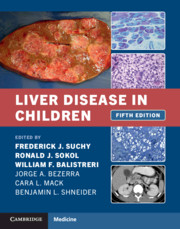Book contents
- Liver Disease in Children
- Liver Disease in Children
- Copyright page
- Contents
- Contributors
- Preface
- Section I Pathophysiology of Pediatric Liver Disease
- Section II Cholestatic Liver Disease
- Section III Hepatitis and Immune Disorders
- Section IV Metabolic Liver Disease
- Section V Other Considerations and Issues in Pediatric Hepatology
- Index
- References
Section II - Cholestatic Liver Disease
Published online by Cambridge University Press: 19 January 2021
- Liver Disease in Children
- Liver Disease in Children
- Copyright page
- Contents
- Contributors
- Preface
- Section I Pathophysiology of Pediatric Liver Disease
- Section II Cholestatic Liver Disease
- Section III Hepatitis and Immune Disorders
- Section IV Metabolic Liver Disease
- Section V Other Considerations and Issues in Pediatric Hepatology
- Index
- References
- Type
- Chapter
- Information
- Liver Disease in Children , pp. 107 - 272Publisher: Cambridge University PressPrint publication year: 2021
References
References
References
References
References
References
References
References
References
Websites for Further Information
Oley Foundation: https://oley.org/default.aspx
American Society for Parenteral and Enteral Nutrition: www.nutritioncare.org/
Short Bowel Syndrome Foundation: http://shortbowelfoundation.org/
GI Kids (NASPGHAN Foundation): https://gikids.org/digestive-topics/short-bowel-syndrome/

